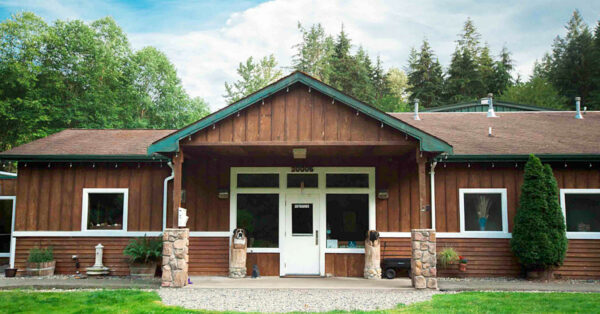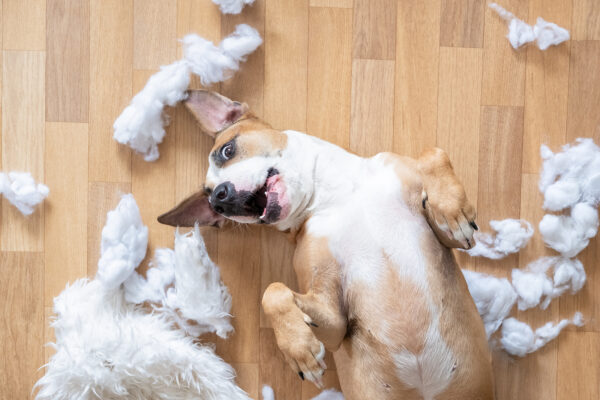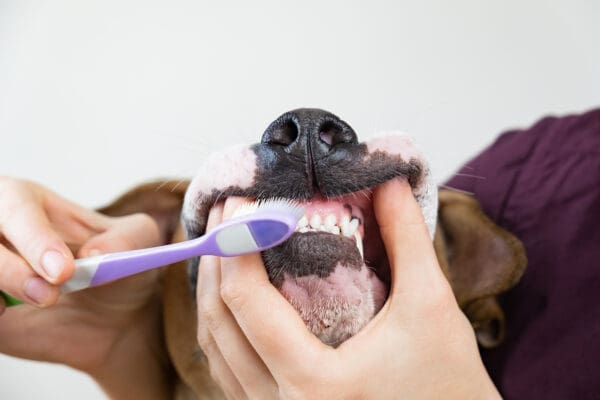
Keeping your pet active, motivated and mentally stimulated is easily accomplished when feeding becomes an activity rather than a routine! Follow these tips from Kristina Whitmer, of Michigan State University’s Veterinary Teaching hospital, on how to change your pet’s routine feeding into an enriching activity.
Enrichment Isn’t Just For Zoo Animals
The benefits of using food as behavioral enrichment have long been recognized by veterinarians and animal husbandry experts. For example, many zoos feed captive wild animals in ways that allow them to express natural behaviors of hunting or foraging. Zoos also use behavior enrichment to prevent animals from getting bored.
Although our household pets are highly adapted to living in a variety of environments, they still have many of the same instincts as their wild ancestors.
There are several effective and easy ways you can make feeding your pet both interesting and rewarding – so, let’s get started!
Before You Begin
Providing your pet with a complete and balanced diet is the cornerstone to a healthy, happy animal. If you’re unsure of the best food type for the animals you love and care for, ask your veterinarian for advice.
Taking The Food Out Of The Bowl
Animals in the wild can spend up to 80% of their day searching for, acquiring and eating their food. Time spent doing these activities means that an animal will maintain its body condition while its mind stays very busy, and it’s burning a lot of energy in the process. Compared to wild animals, the average pet dog and cat spend less than 1% of their day searching for food.
Feeding from a bowl encourages concentrated eating and can often result in over-eating or other problems associated with rapid consumption of food (such as “bloat”).
Although your pet is not a wild animal, it still needs appropriate outlets for spending energy. Most domestic dogs and cats have some level of “prey drive” and if that drive isn’t channeled appropriately, it could lead to behavior problems.
What Do You Do With The Food If It’s Not In A Bowl?
The main goals of enrichment feeding are to increase the time it takes for your pet to eat its food, and to encourage mental stimulation and physical activity.
Pet product companies make “activity toys” that are designed specifically for play and foraging behavior. Toys such as the “Kibble Nibble” (Premier Pet Products) or the “Buster Cube Dog Toy” are two examples of products made to encourage problem solving. Toys such as these are designed to work with typical kibble-style pet foods.
Other products, such as “KONG” brand toys, are more suited to moist or wet foods and can be stuffed (and even frozen) so that your pet spends more time working on eating.
Using different types of toys, and alternating how and when you use them, can help prevent your pet from getting bored too. Just as with food bowls, enrichment toys should be kept clean with warm soapy water, then rinsed and dried well.
Feeding for enrichment is possible on any budget. For example, two or more paper towel rolls could be filled with snacks and hidden around the home. Making a game out of meal time can also be done if you have stairs or a climbing tree for a pet cat. You are only limited by your imagination!
Other Benefits
Obesity Prevention / Treatment
Unfortunately, obesity is responsible for numerous illnesses faced by our pets today. Controlling food intake and increasing your pet’s metabolic rate through daily activity are the keys to preventing and treating obesity.
Just like with people, eating at a more controlled pace helps your pet feel full and satisfied – slower eating can help that hungry pet who needs to loose weight.
Prevent Behavioral Problems
Using food as enrichment can also help prevent behavior problems in pets, such as separation anxiety, inter-pet aggression or destructive actions due to boredom.
The great news is that there is no “wrong” way to provide enrichment. Finding what works best for your pet and your home is the key. Here are a couple of tips to help with the transition:
- Start by feeding 1 meal per day as an ‘enrichment’ meal. Gradually you can build up the amount of time and number of activities offered each day or each week.
- Find activities and toys that are easy to work into your own routine and that your pet enjoys.
- Having several different activities and preparing them ahead of time helps keep your pet on their toes.
- Be persistent and let creativity be your guide! It’s important to experiment, and to know that not everything you try will work.
Additional Resources
• Activity toys are available at:
• Learn more about the canine enrichment program developed by Mackenzie’s Animal Sanctuary Enrichment Program by visiting the ASPCA website.
• “Environmental Enrichment For Captive Animals” by Robert J. Young, Blackwell Press (2003) This is a good resource covering enrichment in all species.
• “Don’t Shoot the Dog” by Karen Pryor
Bantam Books (1999)
Reposted from:
Kristina Whitmer,
Class of 2010
Veterinary Teaching Hospital
Michigan State University
East Lansing, MI 48823



